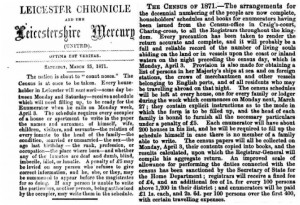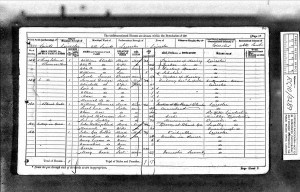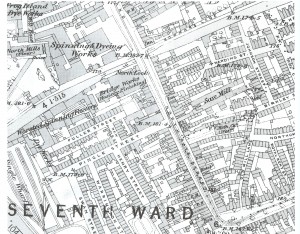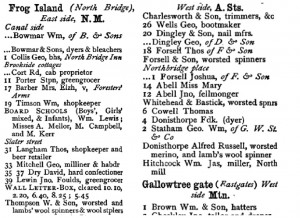We’ve all done it; in the excitement of pursuing an ancestor we gallop through the census returns, from one decade to the next, without giving them more than a cursory look. Yet census returns can tell us so much – they represent a dovetailing of person, time and place. Use them along with old maps, trade directories and local history resources and you can soon develop a clearer sense of life on your ancestors’ streets.
It’s late March 1871 and the Census enumerator pays a visit to the North Bridge Inn. He’s dropping off a form for the householder to complete; as the Leicester Chronicle describes it, “The nation is about the ‘count noses'”.
The schedule requires John George Collis to write down details of all of the people staying under his roof on the night of Sunday 2nd April, including any visitors and servants. “Each enumerator will have about 200 houses on his list,” explains the newspaper report, “and he will be required to fill up the schedule himself in case there is no member of a family able to write. The census papers will all be collected on Monday, April 3, their contents copied into books, and the results calculated, upon which the Registrar-General will compile his aggregate return.” It’s a colossal undertaking, spanning the entire country.
And so it is that we find little George Jennings Collis recorded as a four-month old baby at Frog Island. The pub name isn’t mentioned but the family’s working life is clear – John George is a ‘Victualler’, Emmeline a ‘Waiter in House’ and they’re helped by domestic servant Mary Cave. Baby George’s two sisters – six-year old Cary, especially – are excited by the arrival of their new little brother.
The North Bridge Inn sits beside William Bowmar’s Bleach Works, groom’s cottage and yard. Other neighbours include hosiery trimmers and a coal heaver. Such industry is a reminder that the family home stands next to the Leicester Navigation – the waterway serves as an invaluable source of water, and a means of getting raw materials in and finished goods out. A map (1889) shows the North Bridge Inn (top centre) standing on the junction of Frog Island and Bowmar’s Lane. It’s surrounded by mills: spinning and dyeing works, a worsted spinning factory, and hosiery finishing at Bridge Works.
A trade directory (1875) helps capture another view of who the Collis family meet, day to day, as they walk along Frog Island; children dash to Slater Street school each morning, the postman collects letters from the postbox five times a day, and the whiff of bleach permeates the air. Imagine Emmeline Collis in the the local confectionery shop: “Good morning Mr Dry, a quarter of boiled lemon sweets for the children please”.
Running south from the canal bridge, Northgate Street is a lively thoroughfare:
“I offer your readers a little sketch of that slice of Leicester known as Northgate Street. It extends from Sanvey Gate to Frog Island, but is only 200 yards long: I wish it to be remembered that it is only 200 yards long. Go through almost any morning from 10 to 11 o’clock and you will see something that ought to be described by a realistic French novelist. At this time the street is very much alive with female forms, working women who fill the causeways, accosting one another, chatting to one another; in caps, in hoods, with shawls over their heads, baskets in their hands, and toddling smudge-faced bairns at their apron strings. Very few though are ragged. Here are three butchers’ shops all next door to one another: the cuts are not the prime sort, they look scraggy and bemauled. Shopfronts are dingy, grimy, blackened by friction; eggs and bacon are seemingly in great demand here, the glistening kipper too, and the blowsy bloaters enrich the breeze with their robust perfume, and pawnbrokers hang out their clobber on the outward walls.”
This evocative description was written by journalist Tom Barclay some 23 years after the census (1894) yet the scene would have been similar during George’s childhood. At the time of the 1871 census, Frog Island and Northgate Street were places with plenty of coming and going; the enumerators might have been most interested in ‘counting noses’ but – as resourceful family historians – we can also smell the stench of the bleach works, hear the hum of the worsted spinning factory, and listen in on housewives buying scrags of bacon from the butchers’ shops.
Sources:
Newspaper clippings from The British Newspaper Archives
Census returns from Ancestry
Trade directories from the Historical Directories website
Tom Barclay extract from The Slums of Leicester by Ned Hewitt




One reply on “George Jennings Collis: counting noses and the whiff of bleach (1871)”
[…] Counting noses and the whiff of bleach (1871) […]